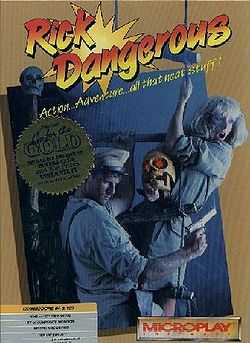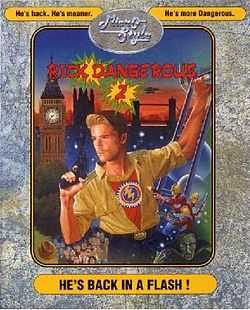Rick Dangerous
| Rick Dangerous | |
|---|---|
 Cover art of Rick Dangerous | |
| Developer(s) | Core Design |
| Publisher(s) | Rainbird Software |
| Platform(s) | Amiga, Amstrad CPC, Atari ST, Commodore 64, ZX Spectrum, DOS |
| Release date(s) | 1989 |
| Genre(s) | Platform |
| Mode(s) | Single-player |
| Distribution | Floppy disk, cassette, cartridge |
Rick Dangerous is a series of two platform games released by Core Design (who would later make Tomb Raider) in the 1980s.
Rick Dangerous was developed by Core Design for the Amiga, Atari ST, Amstrad CPC, ZX Spectrum, Commodore 64 and DOS based PCs. The game was released in 1989 and published by Rainbird Software in Europe and the rest of the world, and on the MicroPlay label (part of MicroProse) in America. Later, it was released with two other games — Stunt Car Racer and Microprose Soccer on the Commodore 64 Powerplay 64 cartridge.
Plot
The plot of Rick Dangerous is largely based on the Indiana Jones movie Raiders of the Lost Ark. Set in 1945, British agent Rick Dangerous travels to the Amazon jungle to search for the lost Goolu tribe. His plane crashes in the jungle, and Rick must escape from the enraged Goolu. When the game starts Rick finds himself in a cave running from a rolling boulder, a famous scene from the Indiana Jones movie.
Armed with a pistol and dynamite, Rick must fight hostiles and evade traps in three more levels. The second level of the game is set inside a pyramid located in Egypt. In the third level, Rick must venture to the Nazi stronghold of Schwarzendumpf castle to rescue captured Allied soldiers. The rescued soldiers tell him that the Nazis are planning a missile attack on London. Therefore, in the last level, Rick must infiltrate their secret missile base.
Gameplay
Rick can jump and climb, as well as carry a limited amount of dynamite and ammunition for his gun. This gun is Rick's primary means of disposing of enemies. Most traps throughout the game that can kill Rick can also kill his enemies, which can be to the player's advantage. The dynamite sticks that Rick carries are generally used for solving puzzles, such as through exploding certain blocks (some of them fly towards the explosion, potentially killing Rick in the backfire). Rick is also armed with a pogo stick that allows him to paralyze enemies.
Unusually, many of the traps in Rick Dangerous have no visible warning, which means that a player's initial progress through the game may consist of trial and error. This was criticized by some reviewers.
Ending
Rick returns to London after completing the last mission, and learns that the city is under attack by aliens.
Rick Dangerous 2
| Rick Dangerous 2 | |
|---|---|
 Rick Dangerous 2 box art | |
| Developer(s) | Core Design |
| Publisher(s) | Micro Style |
| Platform(s) | Amiga, Atari ST, Commodore 64, Amstrad CPC ZX Spectrum, DOS |
| Release date(s) | 1990 |
| Genre(s) | Platform |
| Mode(s) | Single-player |
Rick Dangerous 2 is a platform game developed by Core Design for the Amiga, Atari ST, Amstrad CPC, ZX Spectrum, Commodore 64 and DOS-based PCs. It was released in 1990 and published by Micro Style.
Plot
At the end of Rick Dangerous 1, we learn that an alien invasion is imminent. As Rick Dangerous 2 starts, UFOs land in London. The image shift in the character of Rick Dangerous is evident from the start: The coat is nowhere to be found and the Indiana Jones-style hat from the previous episode is almost symbolically blown off by a laser beam coming from one of the spaceships in the introduction sequence. One UFO lands in Hyde Park, and Rick goes there to settle the score with the aliens.
Gameplay
There are a number of changes to the game play that make the Rick Dangerous 2 more complex and more challenging than its predecessor. For a start, Rick is now armed with a laser gun and bombs that can not only be placed but slid, making way for strategic bomb-placement. The pogo stick is replaced by a punch attack. Rick can also employ a special flying vehicle in certain areas of the game that allows for faster movement, but this may also become a danger factor.
Also, while there is a linear story to the game, the first four levels may be played in any order. Completing these four levels (Hyde Park, the ice caverns on the planet Freezia, the deep forest of Vegetablia and the "atomic mud mines") unlocks the fifth and final level, the Fat Guy's Headquarters, which ends in a boss fight. This level can then be played as often as desired, until the player quits the game, but the endgame movie only plays if the player completes all five levels in order.
Unclosed ending
The end of Rick Dangerous 2 does not complete the story. The game finishes with a cliffhanger, with the Fat Guy escaping at the final moment via a teleporter device, and Rick following him with the familiar captions "What will Rick do next?". Though this may have hinted another sequel to the story, Rick Dangerous 3 was never made. Although a Rick Dangerous 2½ was given away by The One Amiga on a cover disk, this was only a few additional levels and more of a demo than an actual sequel. Many of the concepts featured in these levels were later used in a Super Nintendo Entertainment System game titled Danger Dan, which was also unfinished. Both games were re-released under the budget label Kixx.
Reception
Both Rick Dangerous 1 and Rick Dangerous 2 were highly received by most magazines; for example, Amstrad Action gave Rick Dangerous 2 a 97% rating.[1] However, Zzap!64 only gave Rick Dangerous 1 & 2 a 73% and 75% overall rating respectively, pointing out that the first game was "A playable and fun platform-style game but not much more than that."[2] Amiga Power were highly critical of both games and the reliance on pattern learning.
Initial reaction
Your Sinclair awarded Rick Dangerous with a 78 rating, stating that the game was "A trekkin' good arcade adventure. Simple but tricky, with that vital just-one-more-go element.",[3] while Computer and Video Games gave the Spectrum game an 87%, plus a "C+VG Hit" award, saying that it was "An excellent platform game ..."[4]
The C64 version met with lukewarm reviews; an 84% from CU Amiga-64[5] and a 73% from Zzap!64. Zzap!64 pointed out that the game was "A playable and fun platform-style game but not much more than that."[6]
The Amstrad version also received the same response getting a 76% from The Games Machine,[7] although the game fared slightly better with Amstrad Action who rated it 83% and awarded it with an "AA Rave" accolade.[8]
Amiga reviews were generally positive, ACE giving an 890 rating[9] and Amiga Format giving an 89%.[10]
As with the Amiga, the Atari ST version received positive reviews; 88%[11] and 87%[12] from The One for 16-bit Games and Computer and Video Games, respectively. The One magazine explained that "Rick Dangerous rates as one of the most enjoyable 16-bit arcade games in a long time."[13]
Sequel response
The ZX Spectrum version fared well amongst its respective magazines. CRASH awarded the sequel game a "CRASH Smash" accolade with 90% in their issue 82. "A number one platform game returns with smashingly equal results."[14] Your Sinclair also gave the game a 90 rating, stating "More explore-and-collect frolics, but a whole lot better than the original. " [15]
Amstrad Action, as mentioned above, gave the highest rating of the lot for the Amstrad version, and the highest rated game in AA history at the time, with a 97% rating and a "MasterGame" award.[16] Computer and Video Games also gave the CPC version a high rating of 90%.[17]
Zzap!64 reviewed the C64 version in issue 67 and gave it a 75%,[18] ACE (Advanced Computer Entertainment magazine) awarded the same C64 game an 889 (out of a possible 1000) overall rating.[19]
The Amiga game scored highly as well. CU Amiga gave an 89% rating and a "CU Screen Star" award in their November 1990 issue.[20] Amiga Format awarded the Amiga game their 'Gold' award with a 92% rating.[21] The game was ranked the 17th best game of all time by Amiga Power.[22]
Atari ST reviews were also positive; The One gave the game an overall rating of 90%,[23] while Zero magazine gave an overall 84% rating in its October 1990 review.[24]
References
- ↑ Waring, Adam. Amstrad Action, issue 62, November 1990
- ↑ Wynne, Stuart & Hogg, Robin. Zzap!64, issue 52, August 1989, p 12
- ↑ Ryan, Jackie. Your Sinclair, issue 43, July 1989
- ↑ Rignall, Julian. Computer and Video Games, issue 93, July 1989, p 80,81
- ↑ Dillon, Tony. CU Amiga-64, June 1989, p 33
- ↑ Wynne, Stuart & Hogg, Robin. Zzap!64, issue 52, August 1989, p 12
- ↑ Lapworth, Warren. The Games Machine, issue 20, July 1989, p 44
- ↑ Broadley, Emma. Amstrad Action, issue 48, August 1989, p 47
- ↑ Lacey, Eugene. ACE, issue 25, October 1989, p 44
- ↑ Smith, Andy. Amiga Format, issue 2, September 1989, p 37
- ↑ Nesbitt, Brian. The One for 16-bit Games, issue 9, June 1989, p 66-68
- ↑ Rignall, Julian. Computer and Video Games, issue 93, July 1989, p 80-81
- ↑ Nesbitt, Brian. The One for 16-bit Games, issue 9, June 1989, p 66-68
- ↑ Caswell, Mark. CRASH, issue 82, November 1990
- ↑ Davies, Jonathan. Your Sinclair, issue 59, November 1990
- ↑ Waring, Adam. Amstrad Action, issue 62, November 1990
- ↑ Computer and Video Games, issue 110, January 1991, p 95.
- ↑ King, Phil. & Lapworth, Warren. Zzap!64, issue 67, November 1990
- ↑ ACE (Advanced Computer Entertainment Magazine), issue 40, January 1991, p 115
- ↑ Heley, Mark. CU Amiga, issue 67, November 1990, p 36.
- ↑ Evans, Maff. Amiga Format. issue 16, November 1990, p 82-83
- ↑ Amiga Power magazine issue 0, Future Publishing, May 1991
- ↑ Whitta, Gary. The One. issue 25, October 1990, p 51-52
- ↑ Wilson, David. Zero. issue 12, October 1990, p 57
External links
- Rick Dangerous fan site
- Screenshots from Rick Dangerous
- Rick Dangerous at MobyGames
- Rick Dangerous 2 at MobyGames
- Rick Dangerous at World of Spectrum
- Rick Dangerous 2 at World of Spectrum
- AGDB review of Rick Dangerous 2
- Article revisiting Rick Dangerous 1 & 2
- xrick - open-source clone of Rick Dangerous for Linux/Windows/etc.
- Rick Dangerous - Rick Dangerous for Windows based on XRick
- Flash version of Rick Dangerous
- Rick Dangerous mobile at Magic Productions
- Complete video play-through of Rick Dangerous at recordedamigagames.ath.cx